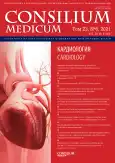Holter monitoring in patients with stable cad: new opportunities
- Authors: Fedulaev Y.N.1, Makarova I.V.1, Pinchuk T.V.1, Andreeva O.N.1
-
Affiliations:
- Pirogov Russian National Research Medical University
- Issue: Vol 23, No 6 (2021)
- Pages: 518-521
- Section: Articles
- URL: https://journals.rcsi.science/2075-1753/article/view/95504
- DOI: https://doi.org/10.26442/20751753.2021.6.200498
- ID: 95504
Cite item
Full Text
Abstract
Full Text
##article.viewOnOriginalSite##About the authors
Yuri N. Fedulaev
Pirogov Russian National Research Medical Universityд-р мед. наук, проф., зав. каф. Moscow, Russia
Irina V. Makarova
Pirogov Russian National Research Medical University
Email: irina-makarova93@mail.ru
ассистент каф. Moscow, Russia
Tatiana V. Pinchuk
Pirogov Russian National Research Medical University
Email: doktor2000@inbox.ru
канд. мед. наук, доц. каф. Moscow, Russia
Olga N. Andreeva
Pirogov Russian National Research Medical Universityканд. мед. наук, доц. каф. Moscow, Russia
References
- Brugada J, Katritsis DG, Arbelo E, et al. 2019 ESC Guidelines for the management of patients with supraventricular tachycardia. Eur Heart J. 20201;41(5):655-720.
- Национальные российские рекомендации по применению методики холтеровского мониторирования в клинической практике. Рос. кардиол.журн. 2014;2(106):6-71
- Knuuti J, Wijns W, Saraste A, et al. 2019 ESC guidelines for the diagnosis and management of chronic coronary syndromes. Eur Heart J. 2020;3(41):407-77.
- Bjerregaard P, El-Shafei A, Kotar SL, Labovitz AJ. ST segment analysis by Holter Monitoring: methodological considerations. Ann Noninvasive Electrocardiol. 2003;8(3):200-7.
- Tzivoni D. Value and limitations of ambulatory ECG monitoring for assessment of myocardial ischemia. Ann Noninvasive Electrocardiol. 2001;6(3):236-42.
- Nurkalem Z, Hasdemir H, Ergelen M, et al. The relationship between glucose tolerance and severity of coronary artery disease using the gensini score. Angiology. 2010;61(8):751-55.
- Huebner T, Goernig M, Schuepbach M, et al. Electrocardiologic and related methods of non-invasive detection and risk stratification in myocardial ischemia: state of the art and perspectives. Ger Med Sci. 2010;8:Doc27. D0I:10.3205/000116
- Окишева Е.А., Царегородцев Д.А., Сулимов В.А. Возможности холтеровского мониторирования в оценке микровольтной альтернации зубца Т и турбулентности ритма сердца у больных, перенесших инфаркт миокарда. Ультразвуковая и функциональная диагностика. 2011;3:59-70
- Nieminen T, Lehtimaki T, Viik J, et al. T-wave alternans predicts mortality in a population undergoing a clinically indicated exercise test. Eur Heart J. 2007;28(19):2332-7.
- Demirta? AO, Urgun OD. Can QTinterval prolongation or dispersion detected in a positive exercise ECG test predict critical coronary artery disease? Arch MedSci Atheroscler Dis. 2019;1(4):7-12.
- Hasan-Ali H, Maghraby MH, Fouad A, Abdel-Sayed A. Corrected QTdispersion improves diagnostic performance of exercise testing in diagnosing coronary artery disease. East Mediterr Health J. 2010;16(1):75-81.
- Helmy H, Abdel-Galeel A, Taha Kishk Y, Mohammed Sleem K. Correlation of corrected QTdispersion with the severity of coronary artery disease detected by SYNTAX score in non-diabetic patients with STEMI. Egypt Heart J. 2017;2(69):111-7.
Supplementary files






